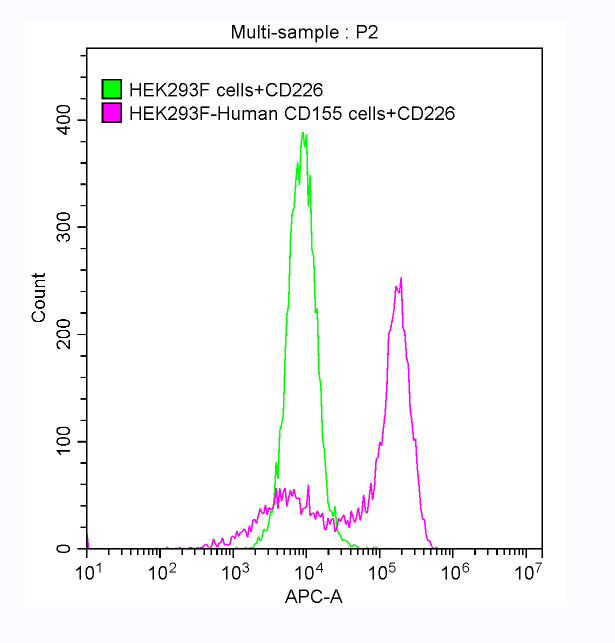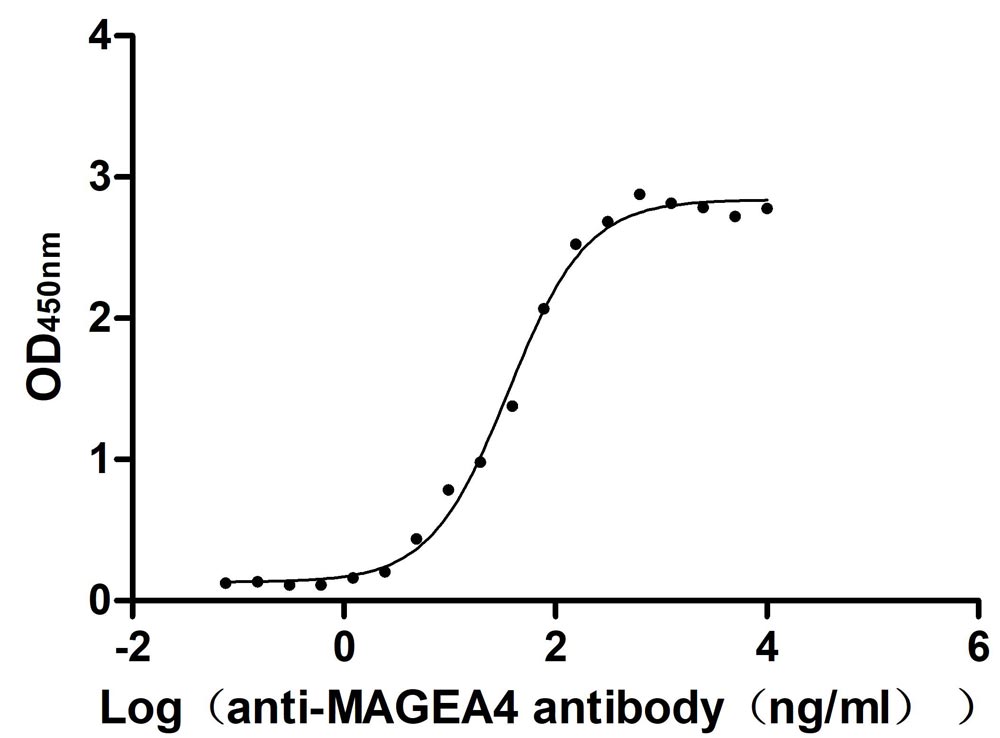Recombinant Mouse Insulin-like growth factor-binding protein 3 (Igfbp3)
-
中文名称:小鼠Igfbp3重组蛋白
-
货号:CSB-YP011097MO
-
规格:
-
来源:Yeast
-
其他:
-
中文名称:小鼠Igfbp3重组蛋白
-
货号:CSB-EP011097MO
-
规格:
-
来源:E.coli
-
其他:
-
中文名称:小鼠Igfbp3重组蛋白
-
货号:CSB-EP011097MO-B
-
规格:
-
来源:E.coli
-
共轭:Avi-tag Biotinylated
E. coli biotin ligase (BirA) is highly specific in covalently attaching biotin to the 15 amino acid AviTag peptide. This recombinant protein was biotinylated in vivo by AviTag-BirA technology, which method is BriA catalyzes amide linkage between the biotin and the specific lysine of the AviTag.
-
其他:
-
中文名称:小鼠Igfbp3重组蛋白
-
货号:CSB-BP011097MO
-
规格:
-
来源:Baculovirus
-
其他:
-
中文名称:小鼠Igfbp3重组蛋白
-
货号:CSB-MP011097MO
-
规格:
-
来源:Mammalian cell
-
其他:
产品详情
-
纯度:>85% (SDS-PAGE)
-
基因名:
-
Uniprot No.:
-
别名:Igfbp3; Igfbp-3; Insulin-like growth factor-binding protein 3; IBP-3; IGF-binding protein 3; IGFBP-3
-
种属:Mus musculus (Mouse)
-
蛋白长度:Full Length of Mature Protein
-
表达区域:28-292
-
氨基酸序列GAG AVGAGPVVRC EPCDARALSQ CAPPPTAPAC TELVREPGCG CCLTCALREG DACGVYTERC GTGLRCQPRP AEQYPLRALL NGRGFCANAS AAGSLSTYLP SQPAPGNISE SEEEHNAGSV ESQVVPSTHR VTDSKFHPLH AKMDVIKKGH ARDSQRYKVD YESQSTDTQN FSSESKRETE YGPCRREMED TLNHLKFLNV LSPRGVHIPN CDKKGFYKKK QCRPSKGRKR GFCWCVDKYG QPLPGYDTKG KDDVHCLSVQ SQ
-
蛋白标签:Tag type will be determined during the manufacturing process.
The tag type will be determined during production process. If you have specified tag type, please tell us and we will develop the specified tag preferentially. -
产品提供形式:Lyophilized powder
Note: We will preferentially ship the format that we have in stock, however, if you have any special requirement for the format, please remark your requirement when placing the order, we will prepare according to your demand. -
复溶:We recommend that this vial be briefly centrifuged prior to opening to bring the contents to the bottom. Please reconstitute protein in deionized sterile water to a concentration of 0.1-1.0 mg/mL.We recommend to add 5-50% of glycerol (final concentration) and aliquot for long-term storage at -20℃/-80℃. Our default final concentration of glycerol is 50%. Customers could use it as reference.
-
储存条件:Store at -20°C/-80°C upon receipt, aliquoting is necessary for mutiple use. Avoid repeated freeze-thaw cycles.
-
保质期:The shelf life is related to many factors, storage state, buffer ingredients, storage temperature and the stability of the protein itself.
Generally, the shelf life of liquid form is 6 months at -20°C/-80°C. The shelf life of lyophilized form is 12 months at -20°C/-80°C. -
货期:Delivery time may differ from different purchasing way or location, please kindly consult your local distributors for specific delivery time.Note: All of our proteins are default shipped with normal blue ice packs, if you request to ship with dry ice, please communicate with us in advance and extra fees will be charged.
-
注意事项:Repeated freezing and thawing is not recommended. Store working aliquots at 4°C for up to one week.
-
Datasheet :Please contact us to get it.
相关产品
靶点详情
-
功能:IGF-binding proteins prolong the half-life of the IGFs and have been shown to either inhibit or stimulate the growth promoting effects of the IGFs on cell culture. They alter the interaction of IGFs with their cell surface receptors. Also exhibits IGF-independent antiproliferative and apoptotic effects mediated by its receptor TMEM219/IGFBP-3R. Promotes testicular germ cell apoptosis.
-
基因功能参考文献:
- Igfbp3-null mouse model was generated in combination with Kras(G12D) to compare the tumor burden. Then, IGF-dependent signaling was assessed after expressing wild-type or a mutant IGFBP3 without IGF binding capacity in non-small cell lung cancer (NSCLC) cells PMID: 28330997
- endogenous (circulating and/or stromal) IGFBP-3 is stimulatory to adipose tissue expansion and enhances mammary tumor growth in immune-competent mice, potentially by suppressing T-cell infiltration into tumors. PMID: 27448965
- High Igfbp3 expression is associated with skin squamous cell carcinoma. PMID: 28807942
- The study shows that the anti-tumoral effect of IGFBP-3 is due to inhibition of the Wnt pathway and depends upon the presence of CD44, a receptor protein known to modulate Wnt signaling. PMID: 27377812
- IGFBP-3 influences severity of DSS-induced colitis. PMID: 27253188
- our studies found that the deletion of IGFBP3 results in behavioral impairments that are associated with abnormal synaptic function and monoaminergic neurotransmission, which helps to characterize the critical role of IGFBP3 in the brain PMID: 28088287
- IGFBP-3 is an aggravating factor during hepatic ischemia-repefusion injury. PMID: 26073647
- An increase in IGFBP-3 post-trauma may play an important role in limiting trauma-induced inflammatory and apoptotic pathways leading to retinal damage. PMID: 25082650
- Even though knockout of IGFBP-3 is associated with only a subtle phenotype under control conditions, our results reveal that loss of this gene has measurable effects on breast carcinogenesis and breast cancer metastasis. PMID: 25614235
- Igfbp3 is a marker for culture-activated hepatic stellate cells and plays a role in HSC migration. PMID: 24358328
- IGFBP-3 has novel protective effects on retinal and systemic vasculature and may be a therapeutic candidate for ocular complications such as diabetic retinopathy. PMID: 22792172
- IGFBP-3 activates inhibitory Smad signaling in 3T3-L1 cells and that endogenous IGFBP-3 modulates their adipogenic differentiation by regulating cell sensitivity towards the inhibitory effect of TGFbeta. PMID: 22910030
- Wnt signaling exerts an antiproliferative effect on adult cardiac progenitor cells through IGFBP3. PMID: 22034491
- IGFBP-3 positively and negatively impacts on IGF1-induced lung cancer development. PMID: 21447628
- Bone morphogenetic protein-1 processes insulin-like growth factor-binding protein 3. PMID: 21697095
- Mice genetically deficient in IGFBP-3 have weaker growth of primary prostate tumors but higher incidence of metastases. PMID: 21697285
- The IGFBP-3/IGFBP-3R system therefore plays a pivotal role in the pathogenesis of asthma and can serve as a newly identified potential therapeutic target for this debilitating disease. PMID: 21383009
- IGFBP-3 has a role in enhanced pericyte ensheathment, reduced microglial activation, increased microglial apoptosis, and neuronal protection after ischemic retinal injury PMID: 21435441
- The s showed that expression of insulin-like growth factor binding protein 3 mRNA increases not only in Borna disease virus P-expressing cultured cells but also in astrocytes from the cerebella of P transgenic mice. PMID: 21325425
- Association between Igfbp3 and risk of prostatic cancer are examined. PMID: 20473871
- This study provides evidence that genetic deletion of IGFBP-3 modulates hepatic carbohydrate and lipid metabolism. PMID: 20926583
- Data indicate that impairment of IGF-1 complex formation with insulin-like growth factor binding protein, acid labile subunit in bone marrow alters cell fate, leading to increased adipogenesis. PMID: 20007694
- IGFBP3 and Humanin play key roles in the coordinated regulation of testicular germ cell homeostasis. PMID: 19952275
- ta indicate that Zik1 and Gja9 demonstrated cancer-specific aberrant DNA methylation, whereas, Cdkn2a/p16, Igfbp3, Mgmt, Id4, and Cxcr4 were methylated in both the AOM tumors and normal colon mucosa. PMID: 19777566
- response to nutritional stsatus chanes in PPARalpha knockout mice PMID: 11735249
- overexpression of hIGFBP-3 results in fasting hyperglycemia, impaired glucose tolerance, and insulin resistance. PMID: 12376320
- IGFBP-3 increases osteoclast number and bone resorption, impairs osteoblast proliferation, and has a significant negative effect on bone formation PMID: 14584894
- N- and C-terminal residues of IGFBP-3 have roles in regulating IGF complex formation and receptor activation PMID: 15485880
- the growth inhibitory effect of mutant IGFBP-3 may be compensated for by other mechanisms PMID: 15550509
- IGFBP-3 induces apoptosis through an insulin-like growth factor-independent nucleomitochondrial translocation of RXRalpha/Nur77 PMID: 15731112
- Overexpression of Hbegf in transgenic mice downregulates Igfbp3. PMID: 16019424
- Igfbp3 modulates cell proliferation in the hair follicle. PMID: 16185287
- IGFBP-3 is upregulated by apigenin in a pathway leading to cancer growth inhibition and apoptosis PMID: 16230333
- the IGF-independent effects of IGFBP-3 may be important in inhibiting tumor progression PMID: 16469805
- IGFBP-3 is a growth inhibitor molecule (news) PMID: 16617154
- provide direct evidence for combinatorial effects of IGFBP-3, -4, and -5 in both metabolism and at least some soft tissues PMID: 16675541
- IGFBP-3 has direct, IGF-independent inhibitory effects on angiogenesis providing an additional mechanism by which it exerts its tumor suppressive effects PMID: 16983336
- IGFBP3 is a downstream gene regulated by MeCP2 and MeCP2 may contribute directly to the transcriptional expression of IGFBP3 in the brain. PMID: 17278996
- In summary, the absence of the IGFBP-5 gene did not block the ability of IGF-I to stimulate intestinal growth, possibly because greater jejunal expression of IGFBP-3 compensates for the absence of IGFBP-5. PMID: 17332154
- IGFBP-3 induces angiogenesis through IGF-I- and SphK1-dependent mechanisms PMID: 17388800
- Igfbp3 regulates hematopoietic stem cell and endothelial precurosr cell function during vascular development. PMID: 17567755
- Igfbp3 suppresses retinopathy through suppression of oxygen-induced vessel loss and promotion of vascular regrowth. PMID: 17567756
- SRC-3 maintains IGF-I in the circulation through enhancing VDR-regulated IGFBP-3 expression. PMID: 18212051
- Data suggest that loss of expression of IGFBPs (IGFBP-3 and IGFBP-4) in tumor cells treated with EGFR tyrosine kinase inhibitors derepresses IGFIR signaling, which in turn mediates resistance to EGFR antagonists. PMID: 18568074
- IGF-I, IGFBP-1 and IGFBP-3 are all inversely related to adiposity in Hispanic children. PMID: 18924579
- IGFBP-3 inhibits adipocyte differentiation. PMID: 19141684
- IGFBP3 is a new regulator of hypocretin cell physiology that may be involved not only in the pathophysiology of narcolepsy, but also in the regulation of sleep in normal individuals, most notably during adolescence PMID: 19158946
- IGFBP-3 binds to fibronectin cell binding domain. PMID: 19236847
- These studies reveal multisite phosphorylation of IGFBP-3 that both positively and negatively regulate its apoptotic potential. PMID: 19556345
- IGFBP-3 mediated chondrocyte apoptosis is regulated by Gli2 and p53 in the progression from benign to malignant cartilage tumors. PMID: 19647223
显示更多
收起更多
-
亚细胞定位:Secreted.
-
数据库链接:
KEGG: mmu:16009
STRING: 10090.ENSMUSP00000020702
UniGene: Mm.29254
Most popular with customers
-
Recombinant Human CD226 antigen (CD226), partial (Active)
Express system: Mammalian cell
Species: Homo sapiens (Human)
-
Recombinant Human Prolactin receptor (PRLR), partial (Active)
Express system: Mammalian cell
Species: Homo sapiens (Human)
-
Recombinant Human Melanoma-associated antigen 4 (MAGEA4) (Active)
Express system: Mammalian cell
Species: Homo sapiens (Human)
-
Recombinant Human Interleukin-17A (IL17A) (T26A) (Active)
Express system: Baculovirus
Species: Homo sapiens (Human)
-
Recombinant Human Myosin regulatory light polypeptide 9 (MYL9) (Active)
Express system: Yeast
Species: Homo sapiens (Human)
-
Recombinant Human Interleukin-2 receptor subunit alpha (IL2RA), partial (Active)
Express system: Mammalian cell
Species: Homo sapiens (Human)
-
Recombinant Human Transmembrane 4 L6 family member 1(TM4SF1)-VLPs (Active)
Express system: Mammalian cell
Species: Homo sapiens (Human)
-
Recombinant Macaca fascicularis Interleukin 1 receptor accessory protein(IL1RAP), partial (Active)
Express system: Mammalian cell
Species: Macaca fascicularis (Crab-eating macaque) (Cynomolgus monkey)





-AC1.jpg)














